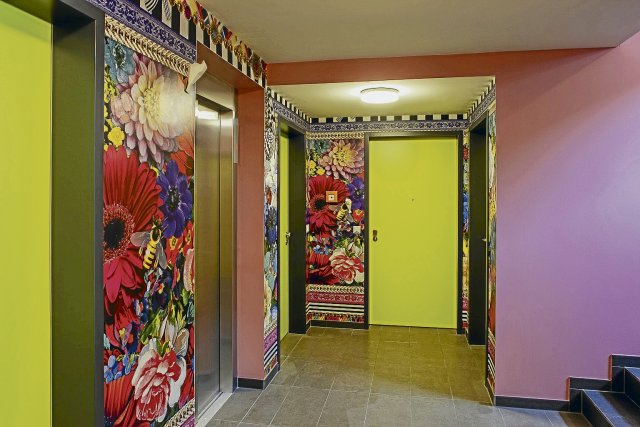There is also art under construction, planned by Eitel and Koch.
Photo: Immprinzip
Who actually lives in social housing? Let’s take a look behind the doors: There’s the actor from the municipal theater who gets great acclaim but only a small salary. Not enough to be able to pay for an adequate apartment for his family at the usual rent. Or the single-parent administrative employee whose part-time job doesn’t pay enough. Or the retired couple who can no longer afford an apartment in a luxuriously renovated old building.
Have you noticed? These are people who would previously have been considered part of the so-called middle class. But housing is becoming increasingly expensive and often unaffordable for these people. Private investors are partly to blame for this. A significant proportion of the apartments built in recent decades were aimed at the upper segment.
The market for it was there. After word got around about the disadvantages of rural life (long commutes, lack of infrastructure, poor leisure activities), wealthier people increasingly moved back to the city. Not just families, but also seniors who realized that a large, empty house is a burden in old age. As a result, luxurious residential complexes with penthouses and lofts boomed, especially since the “concrete gold” seemed to be an attractive investment. And if you were short of change, you could take out a loan that was practically interest-free. It didn’t matter if the five-star apartment in the city was 100,000 euros more expensive than a year before.
The situation on the normal real estate market came to a head. As prices per square meter skyrocketed, affordable housing became scarce. But instead of meeting this demand, construction continued to be expensive. That should take revenge. Every bubble bursts at some point. Does anyone remember the post-reunification building boom in the East? In the end, the number of people who can buy or rent 160 square meter penthouses is manageable. Since inflation and with it mortgage interest rates have been rising, many people are stuck with their overpriced houses and apartments. Properties that were just offered for a million euros are suddenly available for 800,000. Which is still unaffordable for most families.
Jan Eitel, head of a project development and construction company in Trier, saw this development coming in the 10s. This was easy for him because – unusual for a man in the real estate industry – he also knows the other side of the housing market from his own experience. He grew up in public housing and is grateful for it. »Today I know: There would not have been a comparable apartment on the free market for the same money. Of course, I realized earlier that we weren’t rich. Children sense things like that. But our apartment and the environment in which we lived were fine. It was middle class – just affordable.”
This insight benefited him when, in 2016, on the initiative of his long-time partner Martin Koch – also a strong believer – he brought a construction company on board and founded Immprinciple. They didn’t feel like joining another luxury real estate construction company. Instead, a simple, convincing calculation was made: subsidized housing construction means regular income – an affordable apartment always finds tenants.

Photo: Immprinzip
But what about the construction costs? In the past decades, these too have only known one direction: steeply upwards. Above all, the additional construction costs have exploded. Some projects gave the impression that they only served the self-realization of architects. Representative, opulent building – with elaborate facades, patios and monumental staircases – has its price. And this is further increased by maintenance-intensive, failure-prone high-tech. By the time you see the annual statement, “Smart Home” no longer seems so smart.
The demands of the Eitel and Koch duo are different. They want to build sensibly designed social housing with a high level of quality and thermal insulation. And at the same time reduce carbon dioxide emissions. This is neither ecologically nor economically possible with standard concrete construction methods. About eight percent of CO attempted by humans2-Emissions are the result of concrete production. In contrast, even air traffic is moderate at 2.8 percent. At the same time, the production of concrete involves a ridiculous amount of water, gravel and cement. No joke: Even the seemingly endless resource of sand is becoming increasingly scarce – and therefore more expensive.
For the two real estate developers, the question arose: How can affordable housing be built in times of skyrocketing building material costs? They found the answer in the past and in the future at the same time: wood as a material has shaped construction worldwide for thousands of years. Anyone who wasn’t “filthy rich” (and that was very few) relied on this natural, renewable material. There were good reasons for this. And not the least important thing was the robust quality. The countless half-timbered houses all over Europe bear witness to this. There are still two million of these buildings in Germany alone; many of them are over 500 years old.
Eitel and Koch remembered the tried and tested wooden construction and “translated” it into the 21st century. The result is called a wood hybrid. The combination of a grid-like steel skeleton, which extends like straws over several floors, with a wooden structure enables significantly lower production costs.
At the same time, this simple construction principle ensures that planning costs are contained. You don’t need star architects who convince experts and competition juries with their designs, but not the builder who is presented with the bill at the end. Eitel’s social housing has a large balcony and lots of natural light – but no designer chic or high-tech bells and whistles. He won’t win any architectural awards with his apartments, but he will win the hearts of the people who live there.
The details also contribute to this. A stairwell doesn’t have to be expansive to make an impression. Who says that art only exists in museums and picture galleries! Social housing does not have to be accompanied by uniform mass mailboxes and anonymous doorbells. By visually signaling at the main entrance that there are no numbers living here, but rather individuals, the house is upgraded and its residents receive the appreciation they deserve.
And what about financial sustainability? In this respect, too, the subsidized housing brand Immprinzip is convincing. Since the development bank (for example the Rhineland-Palatinate ISB or the Baden-Württemberg L-Bank), the house bank and the mini real estate fund share the financing, every project is on rock-solid economic footing. The rest is automatic: As soon as the tenants have moved in, income flows steadily – unlike empty lofts.
Already at the main entrance it is signaled that there are no numbers living here, but individuals.
Photo: Immprinzip
But the tenants also benefit. Housing will become affordable again. In Karl Marx’s birthplace of Trier, where the company’s roots lie, an average of twelve euros per square meter has to be put on the table. For a social apartment made by Eitel & Koch, however, 6.40 to 6.80 euros are sufficient. And in Mannheim, where a number of projects have also been realized, rents are 30 percent below the local rent.
Immprinciple is also a member of the German Society for Sustainable Building (DGNB). “KfW 40 is a sensible thing, but for us sustainability means more than solid thermal insulation,” explains Koch. With the DGNB he has a partner at his side who promotes and promotes a self-sufficient energy supply. The social housing receives independent direct electricity thanks to heat pumps, photovoltaics and combined heat and power systems. This is cheaper than buying it from energy suppliers.
nd.DieWoche – our weekly newsletter
With our weekly newsletter nd.DieWoche look at the most important topics of the week and read them Highlights our Saturday edition on Friday. Get your free subscription here.
For Eitel, sustainability is also a social concern: “Those who identify with their neighborhood, their neighborhood, become more involved in community life.” His experience is that family-oriented, subsidized housing with capped rents favors mixed, open residential structures – and thus Exchange and engagement. »It is also important to us that different generations come together in our buildings and benefit from each other. Joint services and common rooms contribute to this.«
Jan Eitel therefore sees an opportunity in the current real estate crisis. »Our industry has reached a dead end. Some people are becoming painfully aware of this. Sometimes you just have to fall on your face. Only then do you realize that things can’t go on as usual.«
Become a member of the nd.Genossenschaft!
Since January 1, 2022, the »nd« will be published as an independent left-wing newspaper owned by the staff and readers. Be there and support media diversity and visible left-wing positions as a cooperative member. Fill out the membership form now.
More information on www.dasnd.de/genossenschaft
